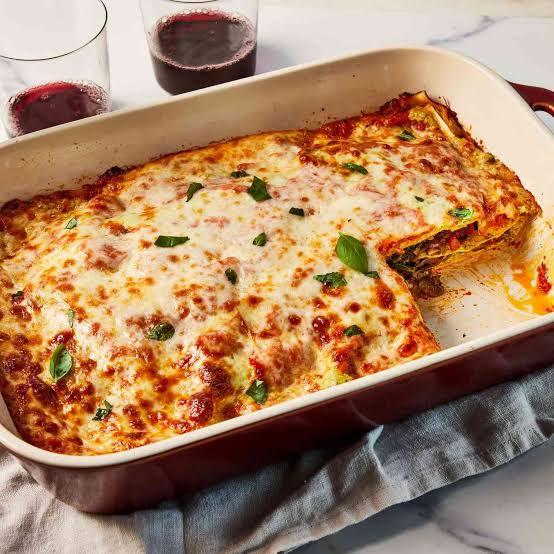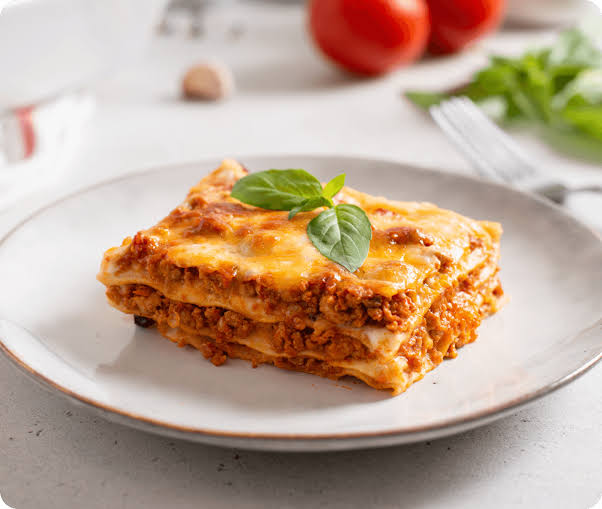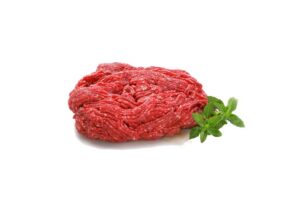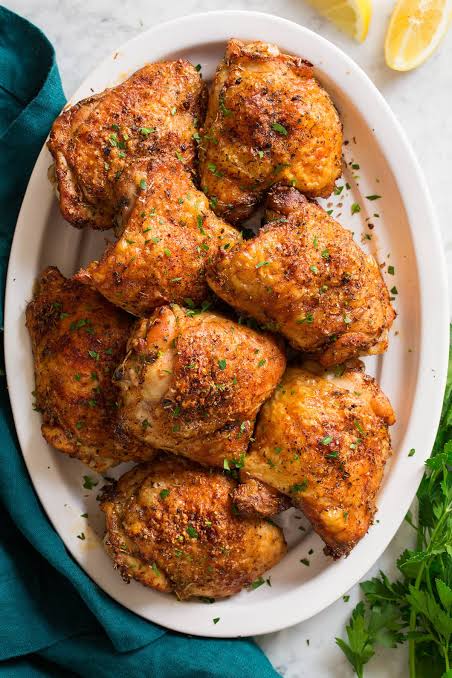About Lasagna recipe :-

Lasagna is a classic Italian dish made with layers of pasta, meat sauce, cheese, and sometimes a béchamel sauce. It is baked in the oven until the top is golden and bubbly. The combination of savory meat, creamy cheese, and tender pasta makes lasagna a comforting and satisfying meal. There are many variations of lasagna, including vegetarian versions, but the basic concept remains the same: layering ingredients to create a flavorful and hearty dish.
Lasagna is a beloved Italian casserole dish known for its rich, layered structure. The word “lasagna” actually refers to the type of wide, flat pasta used in the dish, which is typically boiled before layering. The dish itself, however, is called “lasagne” in Italian, though in English, “lasagna” has become the common term.
why we love lasagna:-

- Layers of Flavor: Each layer in a lasagna adds something special, from the rich, savory meat sauce to the creamy bechamel or ricotta cheese, and the perfectly cooked pasta. The combination of these flavors creates a dish that’s both comforting and complex.
- Cheese: The gooey, melted cheese on top and throughout the layers is a major draw. Whether it’s mozzarella, parmesan, or a blend, cheese adds a satisfying creaminess and richness.
- Comfort Food: Lasagna is the ultimate comfort food. It’s hearty, warm, and filling, making it perfect for a cozy meal, especially in colder weather.
- Versatility: Lasagna can be customized to suit different tastes and dietary needs. Whether it’s a traditional meat lasagna, a vegetarian version, or even a gluten-free or low-carb option, there’s a lasagna for everyone.
- Nostalgia: For many, lasagna is tied to family gatherings, holidays, or special occasions, evoking fond memories. This emotional connection makes it even more appealing.
- Meal-in-One: Lasagna is a complete meal in itself, with protein, carbs, and often vegetables all baked together in one dish. It’s convenient and satisfying.
variation of lasagna:-

Lasagna is incredibly versatile, with many variations catering to different tastes and dietary preferences. Here are some popular and creative lasagna variations:
1. Classic Meat Lasagna
- Ingredients: Ground beef, Italian sausage, marinara sauce, ricotta or cottage cheese, mozzarella, and parmesan.
- Description: This traditional version is rich and hearty, with layers of meat sauce, cheese, and pasta.
2. Vegetarian Lasagna
- Ingredients: Spinach, mushrooms, zucchini, bell peppers, marinara sauce, ricotta, and mozzarella.
- Description: A lighter, meat-free version loaded with vegetables. It can be made with or without cheese.
3. White Chicken Lasagna
- Ingredients: Shredded chicken, white sauce (béchamel or Alfredo), spinach, mozzarella, and parmesan.
- Description: A creamy, comforting alternative to traditional lasagna, featuring a white sauce instead of marinara.
4. Seafood Lasagna
- Ingredients: Shrimp, crab, scallops, ricotta, mozzarella, and a white sauce or marinara.
- Description: A luxurious lasagna option for seafood lovers, often made with a creamy white sauce.
5. Mexican Lasagna
- Ingredients: Ground beef or turkey, black beans, corn, salsa, cheddar cheese, tortillas instead of pasta.
- Description: A fusion dish that replaces lasagna noodles with tortillas and features Mexican flavors like salsa, beans, and taco seasoning.
6. Low-Carb or Keto Lasagna
- Ingredients: Zucchini or eggplant slices as noodle substitutes, ground beef, marinara, ricotta, and mozzarella.
- Description: This variation uses vegetables or low-carb alternatives in place of traditional pasta, making it suitable for keto or low-carb diets.
7. Vegan Lasagna
- Ingredients: Plant-based cheese, tofu or cashew ricotta, vegetables, and marinara sauce.
- Description: A dairy-free, meat-free version that still delivers on flavor with plant-based alternatives.
8. Butternut Squash Lasagna
- Ingredients: Butternut squash, ricotta, mozzarella, sage, and a béchamel sauce.
- Description: A sweet and savory twist on lasagna, often made with layers of roasted butternut squash and a creamy sauce.
9. Pesto Lasagna
- Ingredients: Basil pesto, ricotta, mozzarella, chicken or vegetables, and lasagna noodles.
- Description: This version swaps out marinara for pesto, creating a fresh and aromatic dish.
10. Lasagna Roll-Ups
- Ingredients: Same as traditional lasagna, but with the ingredients rolled up in individual lasagna noodles.
- Description: A fun, individual-sized version of lasagna, perfect for portion control or entertaining.
11. Lasagna Soup
- Ingredients: Ground beef or sausage, lasagna noodles (broken), marinara sauce, ricotta, and mozzarella.
- Description: All the flavors of lasagna in a comforting soup form, perfect for a quick and easy meal.
12. Mushroom and Spinach Lasagna
- Ingredients: Mushrooms, spinach, ricotta, mozzarella, and marinara or white sauce.
- Description: A hearty vegetarian option that focuses on earthy mushrooms and nutrient-rich spinach.
Advantage of eating lasagna:-

Eating lasagna comes with several advantages, both in terms of nutrition and overall enjoyment:
1. Balanced Nutrition
- Carbohydrates: Lasagna noodles provide a good source of energy through carbohydrates, which are essential for fueling your body and brain.
- Protein: Depending on the recipe, lasagna can be rich in protein from ingredients like ground meat, cheese, and even beans in vegetarian versions. Protein is vital for muscle repair, immune function, and overall health.
- Fats: The cheese and meat in lasagna offer healthy fats that are necessary for brain function and hormone production. Using quality ingredients like olive oil can enhance the health benefits.
2. Versatility for Dietary Preferences
- Lasagna can be adapted to meet various dietary needs, whether you’re vegetarian, gluten-free, low-carb, or following a specific eating plan like keto. This versatility allows you to enjoy a satisfying meal that aligns with your health goals.
3. Rich in Vegetables
- Many lasagna recipes incorporate vegetables like spinach, tomatoes, zucchini, and mushrooms. These add vitamins, minerals, and fiber to the dish, contributing to overall health and digestion.
4. Source of Essential Nutrients
- Lasagna ingredients can be rich in essential nutrients. For example, tomatoes in marinara sauce are high in vitamin C and antioxidants like lycopene, which support heart health. Cheese provides calcium for bone health, and fortified lasagna noodles may offer additional nutrients like iron.
5. Comfort and Satisfaction
- Lasagna is known for being a comforting and filling dish. The combination of warm, melty cheese and hearty sauce can help boost your mood and provide a sense of satisfaction, which is important for mental well-being.
6. Great for Meal Prep and Leftovers
- Lasagna is ideal for meal prepping. It stores well in the fridge or freezer and often tastes even better the next day as the flavors meld together. This makes it a convenient option for busy weeks, ensuring you have a nutritious meal ready to go.
7. Social and Cultural Enjoyment
- Lasagna is often associated with family gatherings, celebrations, and communal dining. Sharing a lasagna can foster social connections and bring people together, which is beneficial for emotional health.
8. Customizable Nutritional Profile
- You can control the nutritional content by choosing whole grain pasta, lean meats, low-fat cheeses, or adding extra vegetables. This customization allows you to create a healthier version of lasagna that fits your dietary needs.
9. Energy Boost
- The combination of carbohydrates, fats, and proteins in lasagna provides sustained energy, making it an excellent meal option before physical activities or long workdays.
10. Variety of Flavors
- Lasagna offers a variety of flavors in one dish. This complexity makes it an enjoyable meal that can satisfy cravings for different tastes, from savory to creamy, all in a single serving.
Main ingradients for making lasagna :-

1. Lasagna Noodles
- Type: Wide, flat pasta sheets.
- Options: You can choose between traditional, no-boil, or gluten-free lasagna noodles.
2. Meat Sauce
- Ground Meat: Commonly ground beef, Italian sausage, or a mix of both.
- Marinara Sauce: A rich tomato-based sauce made from tomatoes, garlic, onions, and herbs like basil and oregano.
3. Cheese
- Ricotta Cheese: Creamy cheese for layering.
- Mozzarella Cheese: Shredded mozzarella is used for layering and topping.
- Parmesan Cheese: Grated parmesan for added flavor and a slightly crispy top.
4. Egg
- Use: Mixed with ricotta to add structure and richness to the cheese layer.
5. Seasonings
- Salt and Pepper: For taste.
- Herbs: Fresh or dried basil, oregano, and parsley to enhance the flavor.
6. Olive Oil
- Use: For browning the meat and sautéing vegetables if included.
7. Onion and Garlic
- Onion: Typically diced and sautéed with the meat.
- Garlic: Minced and added to the sauce for extra flavor.

Read this also:- Meatloaf recipe banana bread recipe Meatball recipe Butter milk recipe
Ingredients:-
For the Meat Sauce:
- Olive oil: 15 ml (about 1 tablespoon)
- Onion: 150 g, finely chopped
- Garlic: 10 g (about 2-3 cloves), minced
- Ground beef: 500 g
- Italian sausage: 250 g, casing removed (optional)
- Canned crushed tomatoes: 800 g
- Tomato paste: 70 g
- Tomato sauce: 400 g
- Water: 120 ml (1/2 cup)
- Sugar: 12 g (about 1 tablespoon, optional, to balance acidity)
- Dried basil: 2 g (about 1 teaspoon)
- Dried oregano: 2 g (about 1 teaspoon)
- Salt: 5 g (about 1 teaspoon, or to taste)
- Black pepper: 1-2 g (about 1/2 teaspoon, or to taste)
- Fresh parsley: 10 g, chopped (optional)
For the Cheese Layer:
- Ricotta cheese: 500 g
- Egg: 1 large (about 50 g)
- Grated Parmesan cheese: 50 g
- Fresh parsley: 10 g, chopped (optional)
- Salt: 2 g (about 1/2 teaspoon)
- Ground black pepper: 1 g (about 1/4 teaspoon)
For the Lasagna:
- Lasagna noodles: 250 g (about 12 sheets, depending on the size of your baking dish)
- Shredded mozzarella cheese: 400 g
- Grated Parmesan cheese: 50 g
Process of making:-
- Prepare the Meat Sauce:
- Heat 15 ml of olive oil in a large pot over medium heat. Add 150 g of chopped onions and sauté until translucent, about 5 minutes.
- Add 10 g of minced garlic and cook for an additional 1 minute.
- Add 500 g of ground beef and 250 g of Italian sausage. Cook until browned, breaking the meat into small pieces as it cooks.
- Stir in 800 g of crushed tomatoes, 70 g of tomato paste, 400 g of tomato sauce, and 120 ml of water.
- Season with 12 g of sugar (if using), 2 g of dried basil, 2 g of dried oregano, 5 g of salt, and 1-2 g of black pepper. Add 10 g of fresh parsley if desired.
- Simmer the sauce for at least 30 minutes, stirring occasionally.
- Prepare the Cheese Mixture:
- In a medium bowl, combine 500 g of ricotta cheese, 1 egg, 50 g of grated Parmesan, 10 g of chopped parsley, 2 g of salt, and 1 g of ground black pepper. Mix well.
- Assemble the Lasagna:
- Preheat your oven to 190°C (375°F).
- Cook 250 g of lasagna noodles according to the package instructions. Drain and set aside.
- Spread a thin layer of meat sauce (about 1/3 of the total) on the bottom of a 9×13-inch (23×33 cm) baking dish.
- Place a layer of lasagna noodles (about 4 sheets) over the sauce.
- Spread half of the ricotta mixture over the noodles.
- Sprinkle with 1/3 of the shredded mozzarella (about 133 g).
- Repeat the layers (sauce, noodles, ricotta, mozzarella).
- Top with a final layer of noodles, the remaining sauce, and the remaining mozzarella (133 g) and Parmesan (50 g).
- Bake:
- Cover with aluminum foil (to prevent sticking, you can lightly spray the foil with cooking spray or ensure it doesn’t touch the cheese).
- Bake in the preheated oven for 25 minutes.
- Remove the foil and bake for an additional 25 minutes, until the cheese is melted and slightly golden.
- Let the lasagna cool for about 15 minutes before serving to allow the layers to set.
nutritional value in lasagna recipe:-

The nutritional value of lasagna can vary depending on the specific ingredients and portion sizes used. However, I can provide a general estimate for a typical serving of lasagna made with the recipe provided. Here’s a rough estimate of the nutritional values per serving (assuming the recipe makes about 8 servings):
Estimated Nutritional Values per Serving (1/8 of the Recipe)
- Calories: 450-550 kcal
- Protein: 25-30 g
- Carbohydrates: 45-55 g
- Fiber: 2-4 g
- Sugars: 8-12 g
- Total Fat: 20-30 g
- Saturated Fat: 8-15 g
- Trans Fat: 0-1 g
- Cholesterol: 80-120 mg
- Sodium: 800-1,200 mg
- Calcium: 250-400 mg
- Iron: 3-5 mg
Can I use no-boil lasagna noodles?
Yes, no-boil lasagna noodles are a convenient option. They absorb moisture from the sauce while baking, so there’s no need to pre-cook them. Just make sure your sauce is sufficiently liquid to cook the noodles properly.
How do I make lasagna ahead of time?
You can assemble lasagna up to 24 hours in advance. Cover it tightly with plastic wrap or aluminum foil and refrigerate. When ready to bake, remove the cover and bake at 190°C (375°F) for about 45-60 minutes, or until heated through and bubbly.
Can I freeze lasagna?
Yes, lasagna freezes well. After assembling it, wrap it tightly with plastic wrap and aluminum foil, and freeze. To bake, thaw in the refrigerator overnight and bake as directed. Alternatively, bake from frozen, but it will take longer (about 1.5 to 2 hours).
How do I prevent lasagna from being watery?
To avoid a watery lasagna, make sure your sauce isn’t too thin. You can also drain excess moisture from vegetables if you’re using them. Allowing the lasagna to rest for 15 minutes after baking will also help the layers set and absorb excess liquid.
Can I use a different type of cheese?
Absolutely! You can substitute ricotta with cottage cheese, mascarpone, or a plant-based cheese for different flavors or dietary needs. Other cheeses, such as provolone or gouda, can be used in place of or in addition to mozzarella for a unique taste.
How can I make lasagna vegetarian?
To make a vegetarian lasagna, omit the meat and add more vegetables like spinach, mushrooms, zucchini, or bell peppers. You can also add layers of cooked lentils or beans for added protein.
What’s the best way to layer lasagna?
Start with a thin layer of sauce on the bottom of the dish, then add a layer of noodles. Follow with a layer of cheese mixture, a layer of sauce, and repeat the layers. Finish with a final layer of noodles, topped with sauce and cheese.





